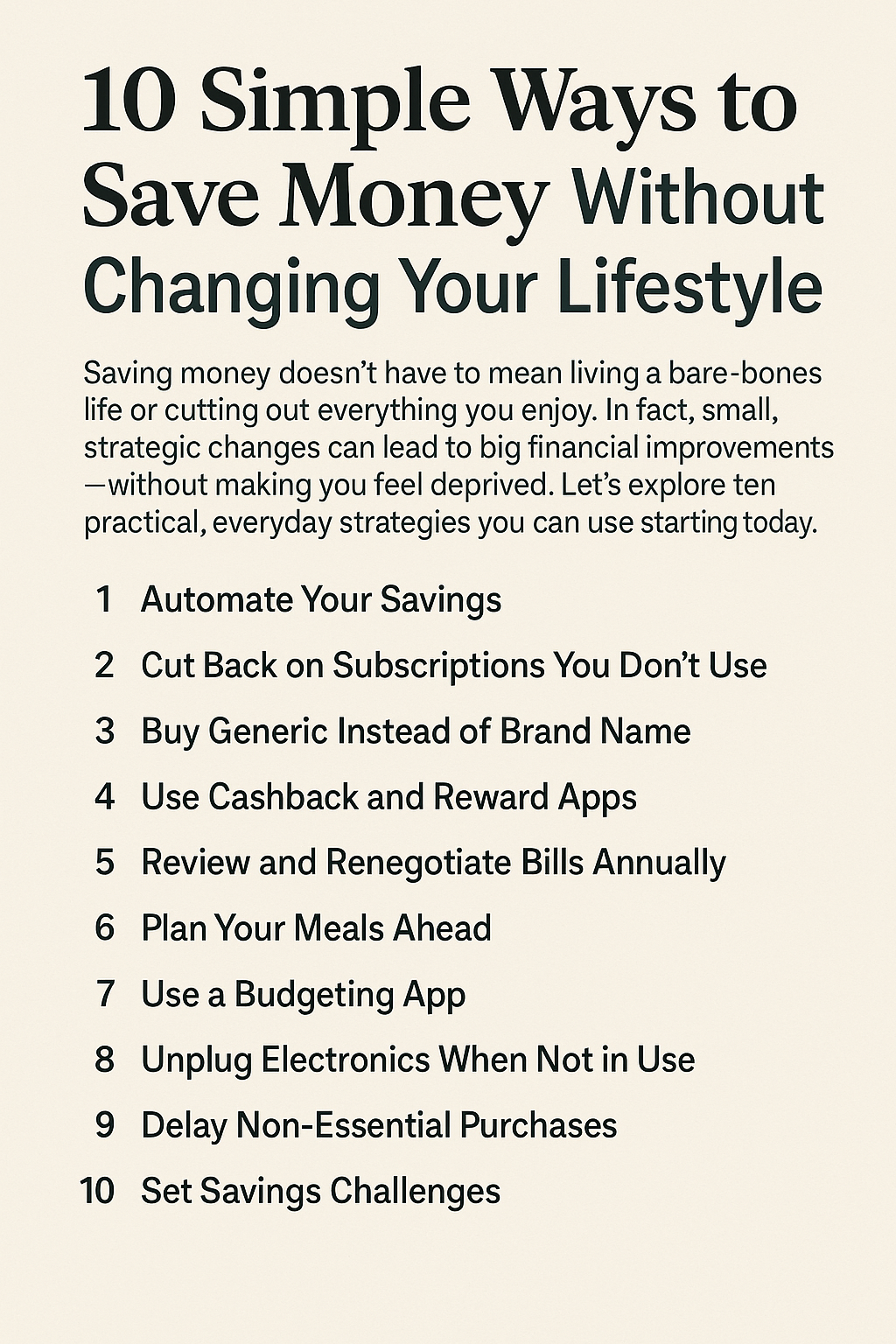Saving money doesn’t have to mean living a bare-bones life or cutting out everything you enjoy. In fact, small, strategic changes can lead to big financial improvements—without making you feel deprived. Whether you’re saving for a financial goal or just want more breathing room in your monthly budget, there are simple ways to keep more of your income without sacrificing your lifestyle.
Let’s explore ten practical, everyday strategies you can use starting today.
1. Automate Your Savings
The easiest way to save money is to take it out of your hands—literally. Set up an automatic transfer from your checking account to a high-yield savings account on payday. This way, saving becomes a habit you don’t even have to think about.
Start small with what you can afford—$10, $50, or more per month—and increase it over time. You won’t miss money you never see.
2. Cut Back on Subscriptions You Don’t Use
Streaming services, fitness apps, premium news, and more—monthly subscriptions add up fast. Go through your bank or app store statements and cancel anything you haven’t used in the past 30 days.
Even if it’s just $5 or $10 a month, cutting two or three unused subscriptions can save you over $300 a year.
3. Buy Generic Instead of Brand Name
For many household items, groceries, and even medications, generic brands are nearly identical to name brands—but significantly cheaper. You won’t notice a difference in quality for most products, but you will see a difference in your budget.
Switching to store-brand products can save you 10–30% on average every time you shop.
4. Use Cashback and Reward Apps
Get rewarded for the purchases you’re already making. Apps like Rakuten, Honey, or Ibotta offer cashback, coupon codes, and discounts for shopping at your favorite stores.
Link your accounts and activate deals with a single tap—it’s money back in your pocket with no extra effort.
5. Review and Renegotiate Bills Annually
When was the last time you checked your internet, phone, or insurance bill? These services often increase their rates over time, banking on you not noticing.
Take a few minutes to compare prices from competitors, or simply call your provider and ask for a better rate. Many companies offer loyalty discounts or promotional pricing just for asking.
6. Plan Your Meals Ahead
Impulse food purchases and last-minute takeout add up fast. Instead of winging it, try planning your meals for the week.
Stick to a shopping list, buy in bulk when possible, and prepare meals at home. You’ll reduce food waste, save money, and eat healthier—all without giving up delicious meals.
7. Use a Budgeting App
Apps like Mint, YNAB (You Need a Budget), and PocketGuard help you track your income, spending, and savings in one place.
When you know where your money is going, it’s easier to identify where you can save—without feeling like you’re sacrificing anything.
8. Unplug Electronics When Not in Use
It may sound small, but electronics that stay plugged in when not in use still draw power—known as phantom energy.
Unplug devices like chargers, TVs, and microwaves or use a power strip to cut power when not needed. You could shave 5–10% off your monthly electricity bill this way.
9. Delay Non-Essential Purchases
When you see something you want to buy, wait 24 to 48 hours before purchasing. This “cooling-off” period helps you decide if the purchase is truly necessary or just impulsive.
Most of the time, you’ll realize you don’t really need it—and your money stays in your account.
10. Set Savings Challenges
Make saving fun with small challenges. For example:
- No-spend weekends
- $5 savings rule: Save every $5 bill you receive
- Spare change jar: Digitally or physically collect your spare change
Gamifying your savings makes it more enjoyable and builds momentum over time.
Final Thoughts: Saving Smarter, Not Harder
You don’t need to make huge sacrifices to save money. By being mindful of your habits, optimizing your spending, and automating the right steps, you can build a strong financial foundation while still enjoying your life.
Start with just one or two of these strategies, and you’ll be surprised how quickly the savings add up. Consistency is key—small steps lead to big results.

